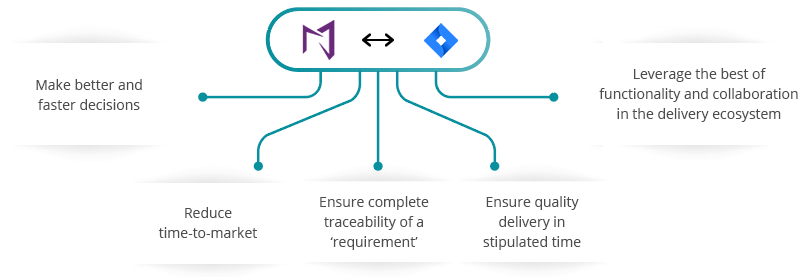Modern Requirements4DevOps Integration with Jira
The integration of Modern Requirements4DevOps and Jira ensures there is no scope for communication gaps or miscommunication between project management and development teams.
Schedule a free 30-minute live demo with our integration experts
Modern Requirements4DevOps and Jira Integration Overview
In an Application Lifecycle Management (ALM) ecosystem, the choice of systems and the collaboration between the cross-functional teams play a great role. While the choice of systems impacts the productivity of a team, the cross-functional collaboration helps the teams get complete context of the business requirements.
Best-of-breed systems such as Modern Requirements4DevOps and Jira bring rich functionalities to the ecosystem. By integrating Modern Requirements4DevOps with Jira, enterprises can seamlessly manage product development. The developers using Jira will have clear visibility into the exact feature requirements and real-time access to any changes/enhancements made to the requirements. On the other hand, Modern Requirements4DevOps users will have a complete view into the development of a requirement that is progressing.
How Modern Requirements4DevOps and Jira integration is beneficial for an enterprise
- Trace the requirement breakdown completely – access the features, tasks, sub-tasks associated with the requirement
- Get complete context of the requirements and receive real-time updates when there is a change in the plan
- Get full traceability into the Quality Assurance (QA) reports from both systems
- Coordinate on the delivery timelines seamlessly with concurrent updates on changes
With Modern Requirements4DevOps and Jira integration, enterprises can:

How OpsHub Integration Manager integrates Jira and Modern Requirements4DevOps
OpsHub Integration Manager integrates Modern Requirements4DevOps and Jira bi-directionally. It ensures that all historical and current data is available to each user, in that user’s preferred system, with full context, in real-time. All ‘requirements’ from Modern Requirements4DevOps automatically synchronize to Jira where they are broken down to ‘stories’. The completion of the story and the status of test results against it automatically synchronizes to Modern Requirements4DevOps.
Popularly synchronized entities

Use Case: Jira integration with Modern Requirements4DevOps
Problem statement: The product management team uses Modern Requirements4DevOps and the development team uses Jira. However, as these systems are not synchronized, the product management team doesn’t have visibility into how the development work is progressing. Any change to the priorities of stories also must be manually communicated.
Solution: When Modern Requirements4DevOps and Jira are integrated, the coordination between the product management team and development team will be seamless.
- The Product Manager logs a ‘user story’ Modern Requirements4DevOps.
- The Product Manager defines the user story’s specifications and attaches a few emails from the users in Modern Requirements4DevOps.
- The new ‘user story’ synchronizes to Jira along with specifications and emails.
- The development team starts work on the story and changes the status of the ‘story’ to ‘In Progress’.
- The status of the ‘story’ changes to ‘In Progress’ in Modern Requirements4DevOps as well – the Product Manager, is thus notified, that the development work on the new story has started.

Benefits of integration for Jira and Modern Requirements4DevOps users
Modern Requirements4DevOps
users
- Traceability for business requirements throughout
the ALM tool chain - Visibility into the progress of development work
- No dependency on manual communication for
making business decisions
Jira users
- Real-time updates on feature requirements and associated changes/enhancements
- Complete context of the business requirements
- No manual efforts needed to keep product management teams updated on the development status
